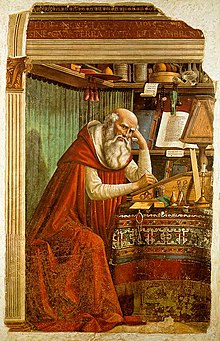Illyrian education
Based on the latest scientific research and discoveries in various aspects of Illyrology: historical, archeological, epigraphic, linguistic, paleographic, etc., it has become possible to better summarize the Illyrian educational system.
Archaeological research proves the existence of the gymnasium in the Greek colony of Apollonia since the end of the 6th century BC.
[4] Later, gymnasiums and other educational institutions were opened in cities such as Amantia, Byllis,[5] Durrës, Epidaurum,[6] Nikaia,[7] Historical evidence speaks of the Hellenistic School of Apollonia, in which in 44 Julius Caesar's nephew, Octavian Augustus, was also a student, probably because in this educational institution taught prominent scholars of the time.
The ancient Greek geographer and historian Strabo in his work Geographica describes it as "a city with good laws" (polis eunomotate).
[9] Even the Roman orator Cicero, who had visited these areas in 58 in his work Philipicae, described Apollonia as a "great and majestic city" (Latin: magna urbs et gravis) with a school of philosophy and oratory.
In different historical periods, Greek and Roman educational institutions functioned in Illyria in which the children of the rich Illyrian strata attended classes.
The main cities never lacked stoas (promenades), which were public buildings for the development of political, literary and philosophical conversations.
In general, the political, cultural and religious life in the Illyrian civic communities took place in gymnasiums, promenades, theaters, stadiums, temples, etc.
In general, prominent scholars and personalities, distinguished military commanders and statesmen (kings) emerged from the Illyrian schools and educational system.
[17] According to Cicero, Illyrian women were "as powerful and industrious as their husbands, they guarded cattle, brought wood to their hearths, and prepared food.
"[18] After this period the children of free citizens, of the middle and upper classes of Illyrian society continued their education in grammar schools.
During this period special attention was paid to the physical development of young people, mainly through gymnastic exercises and athletics.
Due to the importance of ephebos, the preparation of young people in this period took place under the direct care of the Illyrian state and civic communities.
During the archeological excavations in the tomb of the teacher Mark Lugari, the writing tools that were used by the students in the school at that time were discovered.
[7] On the belt of this teacher hung a leather holder, in the holes of which were inserted writing sheets of papyrus or parchment, collected in a cylindrical shape.
[26] According to reliable sources of archaeo-musicology, including those British, French and Italian, Nicetas has written, “I am Dardanian” (Latin: “Dardanus sum”).
This focus stemmed from his close patron relationships with several prominent female ascetics who were members of affluent senatorial families.







